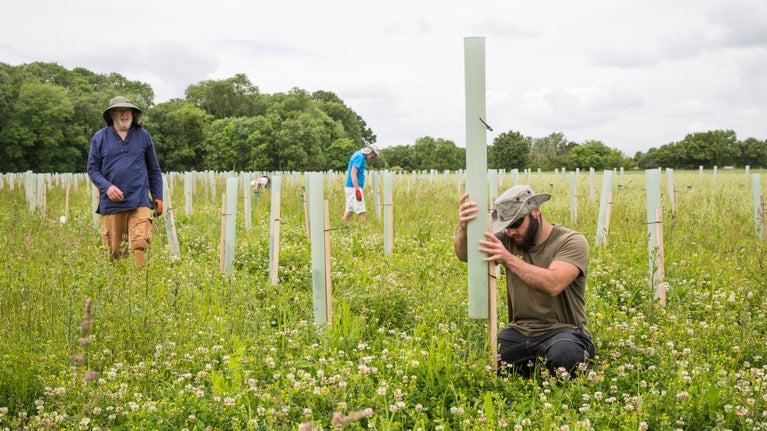
Tackling climate change
Uncover how we’re responding to the changing climate at places in our care.

With support from the Government’s Green Recovery Challenge Fund, we’re resolved to secure our future with action on climate and the environment, while ensuring people can enjoy nature on their doorstep, access local heritage and come together in shared cultural spaces. To this end, we're working hard to plant trees and hedgerows, restore floodplains, protect wildlife and store carbon at the places in our care.
In November 2020, we found out we were successful in two funding bids: 'Historic Landscapes' and 'Ancient Woodland and Trees' (led by the Woodland Trust).
The two programmes of work not only help to tackle the climate and nature emergencies but also boost the economy by creating and retaining jobs within the sector. This stimulates demand and supports longer-term sustainable growth, as well as inspiring the conservationists and foresters of the future.
The 'Historic Landscapes' programme has been awarded £3.85 million by Defra as part of the Green Recovery Challenge Fund. This programme of work, worth more than £4.7 million, will kickstart the development of a new purpose for five of our most historic landscapes. This means these treasured historic estates will also lead the way in delivering a much wider range of benefits for nature, carbon reduction and people.

Aerial mapping technology is helping us identify areas to plant 75,000 trees at the Wallington Estate in Northumberland thanks to funding from the Government's Green Recovery Challenge Fund.
The £800,000 project is using LiDAR (Light Detection and Ranging) technology to uncover historic farming practices and archaeological aspects of the landscape dating back to 2,000 BC. This means we can protect and conserve these areas while identifying the best places for tree planting and hedgerow creation.
So far, aerial mapping has helped us discover 120 archaeological features, including evidence of 'ridge and furrow' cultivation, field boundaries, a 17th-century recreational landscape and cleared woodlands.
Ancient woodland continues to be destroyed and now only covers 2.5 per cent (609,990ha) of the UK's land mass, according to research from the Woodland Trust. The charity's report, State of the UK's Woods and Trees 2021, highlighted that 1,225 ancient woods are under threat from development and at least 981 have been permanently lost or damaged during the last 21 years.
This is why we're working with Woodland Trust to protect and restore ancient trees, woodlands and wildlife habitats. The Green Recovery Challenge Fund has provided funding of £3.86m to help us do this. In total, the partnership is delivering a £4.6m programme of work across 60 sites (918ha) cared for by the National Trust, Woodland Trust and by private owners.

The work, led by the Woodland Trust, will not only help tackle the climate and nature emergencies but also boost the economy by creating and saving jobs in the forestry sector. The 15-month programme, which started in January 2021, is taking place across England and will include the restoration of ancient woodland (191ha) at sites we look after in Devon and the East of England.
We'll also survey the most valuable ancient and veteran trees in our care using the Woodland Trust's Ancient Tree Inventory. This will help us record any gaps in our knowledge about the threats they face so we can better restore them in the future.

Uncover how we’re responding to the changing climate at places in our care.

This project is funded by the government’s Green Recovery Challenge Fund. The fund is being delivered by The National Lottery Heritage Fund in partnership with Natural England and the Environment Agency.

The UK's largest woodland conservation charity.
From tips on saving water to combatting plastic pollution, learn more about our work to protect precious coasts and rivers for wildlife and people, and what you can do to help.

Discover how we’re helping increase butterfly populations through habitat management and monitoring, and learn about the rare species we’re bringing back from the brink.

Hedgerows and orchards provide food for insects, homes for wildlife and a spectacle of spring blossom for humans. However, they are disappearing from UK landscapes. Find out more about what we're doing to bring blossoming trees and hedgerows back.
Discover more about the National Trust’s role at COP26 in Glasgow and how you can help tackle the climate crisis.

We look after some of the UK's most important nature reserves. Visit a nature reserve near you and discover a wide range of wildlife and plantlife.
